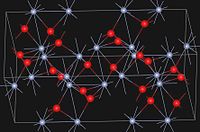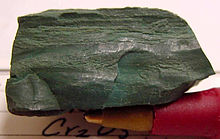- Chromium(III) oxide
-
Chromium(III) oxide 
 Other namesChromium sesquioxide
Other namesChromium sesquioxide
Chromia
Chrome green
EskolaiteIdentifiers CAS number 1308-38-9 
PubChem 517277 ChemSpider 451305 
UNII X5Z09SU859 
ChEBI CHEBI:48242 
RTECS number GB6475000 Jmol-3D images Image 1 - O=[Cr]O[Cr]=O
Properties Molecular formula Cr2O3 Molar mass 151.99 g/mol Density 5.22 g/cm3 Melting point 2435 °C, 2708 K, 4415 °F
Boiling point 4000 °C, 4273 K, 7232 °F
Solubility in water insoluble Solubility in alcohol soluble in acids Refractive index (nD) 2.5  oxide (verify) (what is:
oxide (verify) (what is:  /
/ ?)
?)
Except where noted otherwise, data are given for materials in their standard state (at 25 °C, 100 kPa)Infobox references Chromium(III) oxide is the inorganic compound of the formula Cr2O3. It is one of principal oxides of chromium and is used as a pigment. In nature, it occurs as the rare mineral eskolaite.
Contents
Structure and properties
Cr2O3 adopts the corundum structure, consisting of a hexagonal close packed array of oxide anions with 2/3 of the octahedral holes occupied by chromium. Similar to corundum, Cr2O3 is a hard, brittle material (Mohs hardness 8-8.5).[1] It is antiferromagnetic up to 307 K, the Neel temperature.[2][3] It is not readily attacked by acids or bases, although molten alkali gives chromites (salts with the Cr
2O2−
4 anion, not to be confused with the related mineral chromite). It turns brown when heated, but reverts to its dark green color when cooled. It is also hygroscopic.Occurrence
Cr2O3 occurs naturally in mineral eskolaite, which is found in chromium-rich tremolite skarns, metaquartzites, and chlorite veins. Eskolaite is also a rare component of chondrite meteorites. The mineral is named after Finnish geologist Pentti Eskola. [1]
Production
The Parisians Pannetier and Binet first prepared the transparent hydrated form of Cr2O3 in 1838 via a secret process, sold as a pigment.[4] It is derived from the mineral chromite, (Fe,Mg)Cr2O4. The conversion of chromite to chromia proceeds via Na2Cr2O7, which is reduced with sulfur at high temperatures:[5]
- Na2Cr2O7 + S → Na2SO4 + Cr2O3
The oxide is also formed by the decomposition of chromium salts such as chromium nitrate or by the exothermic decomposition of ammonium dichromate.
- (NH4)2Cr2O7 → Cr2O3 + N2 + 4 H2O
The reaction has a low ignition temperature of less than 200 C and is frequently used in "volcano" demonstrations.[6]
Chromium oxide can be converted into elemental chromium metal through a thermite-like reaction: unlike iron oxide thermites, chromium oxide thermites creates few or no sparks, smoke or sound, but glow brightly. Because of the very high melting point of chromium, chromium thermite casting is impractical.
Applications
Because of its considerable stability, chromia is a commonly used pigment and was originally called viridian. It is used in paints, inks, and glasses. It is the colourant in "chrome green" and "institutional green." Chromium(III) oxide is the precursor to the magnetic pigment chromium dioxide, according to the following reaction:[5]
- Cr2O3 + 3 CrO3 → 5 CrO2 + O2
It is one of the materials that are used when polishing the edges of knives on a piece of leather (also called stropping). In this context it is often known as green compound.
Reactions
Chromium(III) oxide is amphoteric. Although insoluble in water, it dissolves in acid to produce hydrated chromium ions, [Cr(H2O)6]3+. It dissolves in concentrated alkali to yield chromite ions. When heated with finely divided aluminium or carbon, it is reduced to chromium metal and aluminum oxide:
- Cr2O3 + 2 Al → 2 Cr + Al2O3
Heating with chlorine and carbon yields chromium(III) chloride:
- Cr2O3 + 3 Cl2 + 3 C → 2 CrCl3 + 3 CO
Chromates can be formed by the oxidation of chromium(III) oxide and another oxide in a basic environment:
- 2 Cr2O3 + 4 MO + 3 O2 → 4 MCrO4
See also
References
- ^ a b "Eskolaite". Webminerals. http://webmineral.com/data/Eskolaite.shtml. Retrieved 2009-06-06.
- ^ J.E Greedan, (1994), Magnetic oxides in Encyclopedia of Inorganic chemistry R. Bruce King, Ed. John Wiley & Sons. ISBN 0471936200
- ^ A. F. Holleman and E. Wiberg "Inorganic Chemistry" Academic Press, 2001, New York. ISBN 0-12-352651-5.
- ^ Eastaugh, Nicholas; Chaplin, Tracey; Siddall, Ruth (2004). The pigment compendium: a dictionary of historical pigments. Butterworth-Heinemann. p. 391. ISBN 0750657499.
- ^ a b Gerd Anger, Jost Halstenberg, Klaus Hochgeschwender, Christoph Scherhag, Ulrich Korallus, Herbert Knopf, Peter Schmidt, Manfred Ohlinger, "Chromium Compounds" in Ullmann's Encyclopedia of Industrial Chemistry, Wiley-VCH, Weinheim, 2005.
- ^ Ammonium dichromate volcano Retrieved 2009-06-06.
Chromium compounds Categories:- Chromium compounds
- Oxides
- Inorganic pigments
- Alchemical substances
- Common oxide glass components
- Abrasives
- Sesquioxides
Wikimedia Foundation. 2010.

